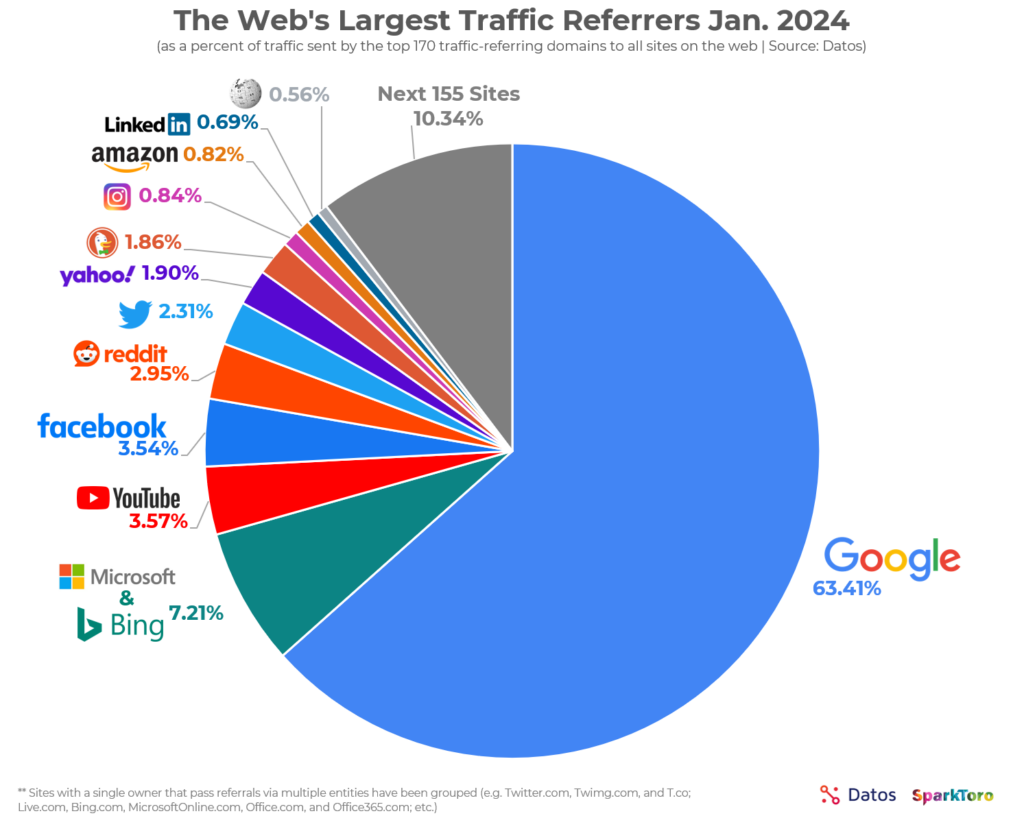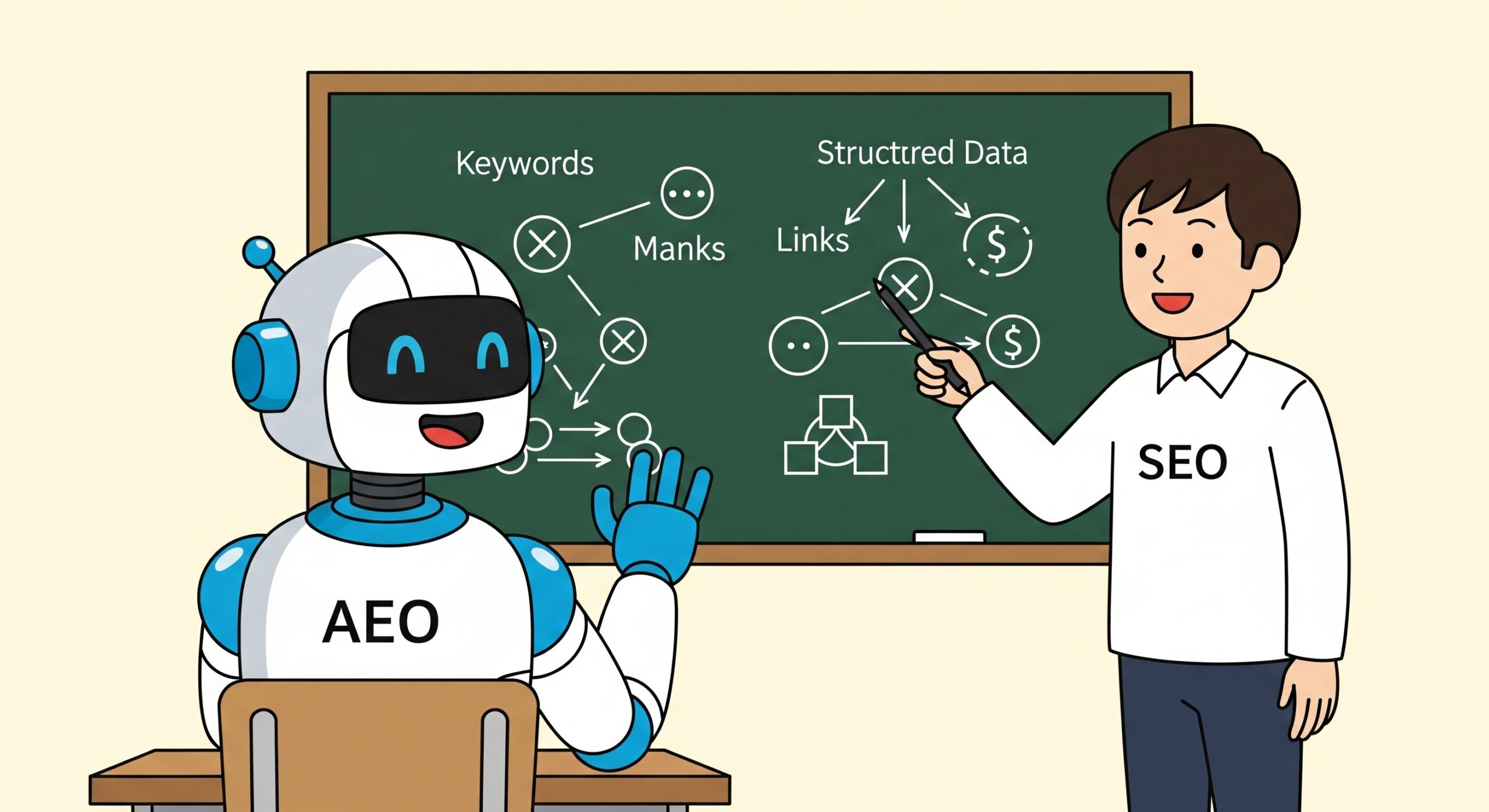Shelly Palmer of Syracuse University recently published a piece titled “SEO to AEO: The Transition Begins.” It follows a familiar pattern in our industry: declaring that SEO is dead, has been forever changed, requires bold new thinking, or is undergoing a paradigm shift that demands marketers “wake up.”
Cue Gary Vee yelling at you because you don’t “get it.”
Yet, the advice that Palmer gives for facing the “AEO future” sounds a lot like the SEO past. Specifically, Palmer recommends you:
- Fortify your data infrastructure
- Rewrite for quotability
- Test every available beta program
- Shift measurement from traffic to outcomes
- License unique assets proactively
Let’s take these on one-by-one.
Data Infrastructure
Let’s call this “structured data,” a term that’s very familiar to SEOs. The entire web is a project in structuring data, but the kinds of markup that Palmer is referencing in his piece go back to the 2011 founding of Schema.org, a standards body including Google, Yahoo, Microsoft, and Yandex.
Palmer specifically says that “organizations are investing heavily in clean product feeds, comprehensive FAQ markup, and detailed schema implementations” in reaction to AI. Those are all worthy endeavors, but organizations should have been heavily investing in structured data for the last decade and a half. It’s always been one of the greatest drivers of traffic for our clients. In other words, it’s classic SEO.
That said, structured data does seem to serve two new purposes in the world of AEO. First, it acts as a sort of crutch for new search engines like SearchGPT and Perplexity that don’t have 25 years worth of knowledge baked into a mature search algorithm like Google’s.
Second, at the other end of the search sophistication spectrum, Google’s new AI Mode uses a technique called “query fan-out” to generate synthetic searches in addition to the user’s original prompt. This means that in order to be cited in AI answers, your website may need to appear in multiple sets of search results. Thankfully, by adding structured data around topics, our TopicalBoost users tend to appear in results for a variety of keywords, and are thriving in AI mode. TopicalBoost, also drives tremendous amounts of traffic from Google Discover and Google News, two query-less traffic referrers.
So again, structured data, a tried-and-true SEO method, works in the world of AEO, but isn’t new.
Quotability
Here Palmer recommends content writers deploy “concise, declarative statements that AI systems can lift verbatim.” Good advice, for sure, but this same advice has been out there since 2014 when Google debuted Featured Snippets and Amazon launched the Echo.
This is when the transition from search engine to answer engine started entering the marketing conversation, and the sky was supposedly falling because of “zero-click” searches. Publishers decried the lifting of answers w/o traffic being sent their way. Google did this through direct quotes at the top of results. Amazon did this by providing spoken answers, sometimes with citations, but with no ability at all for voice users to “click” on a link.
Where this is new for AEO is in the ex-post-facto method of adding citations that’s unique to AI. Unlike the notecards with APA-style citations that I used to gather sources for my college term papers, AI doesn’t really track its sources. Instead, it generates an answer from a collection of sources and then figures out which sources best fit what it wrote. This after-the-fact backfilling of sources favors short sentences with fewer subordinate or dependent clauses. We should be writing that way already because it’s a better, clearer way to communicate, but AI gives us additional reason to focus on clarity and easily-parsed prose.
Quotability isn’t new, but this SEO method has a new application in the world of AEO.
Testing Beta Programs
This is really good advice. I tend to learn best through trial and experimentation and this is probably the best way to understand how to start targeting AI answers in your niche.
SEO is highly specific to your site’s niche, and targeting ads against AI answers will likely be no different. Getting a feel for how this works within your niche and taking advantage of low CPC rates in these early days is smart use of your time.
I’m going to give this to Palmer. Ads in AI Overviews will be a new AEO thing.
Measurement
Just as the debut of Featured Snippets ate away at the traffic for commodity information like dictionaries or weather sites, AI overviews are going to take away from other top-of-funnel pages. These are the sort of pages that explain something in broad terms, define something, or provide basic information. Users are probably going to start preferring AI synthesized answers to these questions that cite a variety of sources.
But we also know from Kevin Indig’s study of user behavior in AI Overviews that users also want “reassurance” when interacting with AI overviews, especially in what Google calls “YMYL” or “your money, your life” queries—such as searches on medical or financial topics.
This is good news for publishers in high-stakes fields—like think tanks and public policy groups—who write about topics where the answer must be right, not just “probably right,” which is the typical output of an LLM.
However things shake out, year-over-year comparisons across metrics are definitely out the window for now. Things are in flux, so keeping an eye on the bottom line is crucial.
So yes, focusing on bottom-line measurements like conversions is good advice, but it’s always been good advice and isn’t new to AEO.
Unique Assets
The understanding used to be that publishers would grant access to their content in exchange for traffic being referred to them in droves. But the same study cited above from Kevin Indig notes that heavy AI users “pick AIO as the final answer in 1 of 2 queries,” which means a new economic model of the web will have to take shape.
AI won’t work without new information being published and publishers won’t generate that new information if AI companies are hoovering it up without compensation. Publishers will need to be remunerated in clicks, cash, or something else that eventually leads to cash, or the old system based on mutual benefit will collapse.
Few sites outside the New York Times or Reddit have the leverage to get a licensing deal out of the big AI companies. However, Cloudflare, a CDN and security provider used by nearly 20% of all websites, is creating tools to allow smaller content creators to band together and collectively bargain with AI tools.
This sort of thing is unique to Palmer’s proposed AEO world because the fundamental bargain that Google struck with publishers is breaking down.
How Does this Affect SEO?
Ultimately, I don’t think Palmers’s advice is bad—it’s actually quite good—I just don’t think most of it is new or part of a uniquely AEO paradigm.
Traditional SEO methods are still vitally important. Web content has to be accessible whether it’s being presented as an AI-generated essay or a list of links on a search engine. My team and I are shocked at how many websites are still inaccessible or unintelligible to web crawlers.
AI won’t get around these technical barriers; in fact, most AI companies are worse at crawling and parsing the web than Google, so solid technical SEO is growing in importance.
Because AI tools use search engines to generate their answers, AI systems won’t so much replace search engines as they’ll become their biggest users. Search engines rely on signals like links or branded queries to elevate authoritative sources and weed out spam. Making those signals clearer will still be a job for SEOs.
If AI captures 50% or even more of the traffic that search engines once referred to websites, search engines will still be driving significant traffic. SEO changes that might have grown organic traffic by 400,000 visitors a month in 2024 would still be generating an additional 200,000 visitors a month in 2025. And those new visitors will be especially valuable if they are more likely to engage deeply: downloading reports, subscribing to newsletters, or contacting policy experts.

In other words, search is so incredibly dominant now—Google alone refers over 63% of all traffic on the web—that even if a portion of those referrals evaporated entirely it would still represent billions of potential website visits a day. That’s still a whole lot of human attention worth seeking out.
Methods will undoubtedly change over time as the information discovery ecosystem continues to evolve, but the market for SEO services will remain because the opportunities for boosting traffic will still be enormous.


